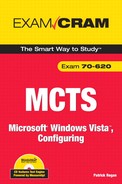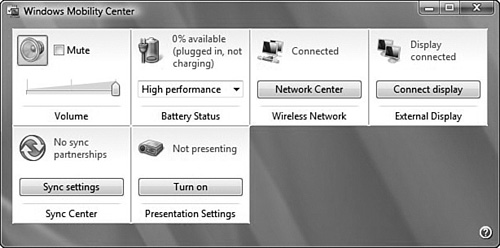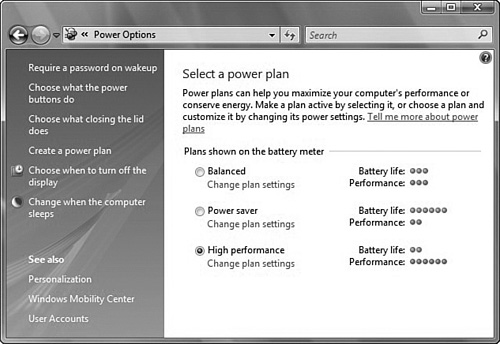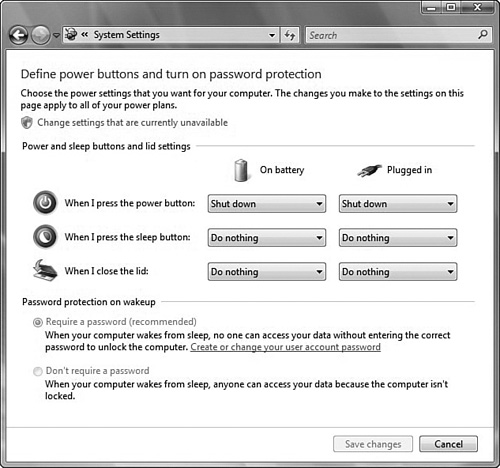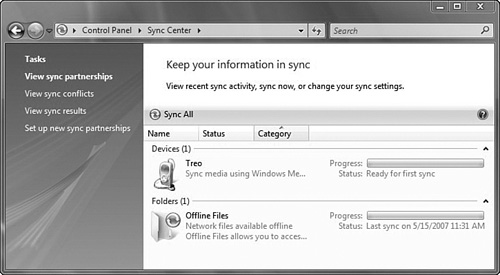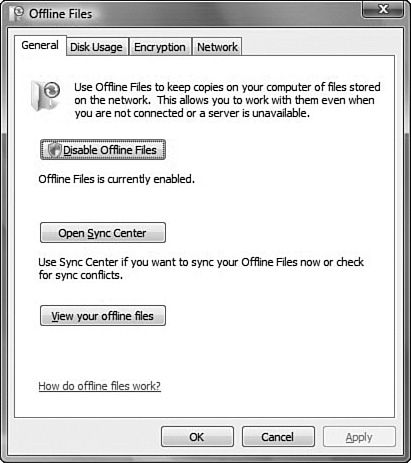Terms you’ll need to understand:
✓ | Windows Mobility Center |
✓ | Power plans |
✓ | Hibernate mode |
✓ | Sleep mode |
✓ | Hybrid Sleep |
✓ | Battery meter |
✓ | Sync Center |
✓ | Offline folder |
✓ | Bluetooth |
✓ | Windows Mobility Device Center |
✓ | Presentation mode |
✓ | Windows SideShow |
✓ | Tablet PC |
✓ | Flicks |
Techniques/concepts you’ll need to master:
✓ | Configure Power Management to balance performance and battery life. |
✓ | Compare and differentiate Sleep, Hybrid Sleep, Hibernate, and Shutdown. |
✓ | Use the battery meter to monitor power levels. |
✓ | Use the Sync Center to synchronize offline files. |
✓ | Use the Sync Center to connect mobile devices. |
✓ | List the features of Presentation mode. |
✓ | Use Windows SideShow to check e-mail or access Windows Media Player. |
✓ | Configure Windows Vista to support Tablet PCs, including configuring flicks. |
Mobile computers are computers that are meant to be mobile. Just like desktop computers, mobile computers (including laptops, notebook computers, Tablet PCs and Ultra-Mobile computers) can come in various sizes and configurations. In any case, mobile computers bring a set of challenges because they are not always connected to the Internet or corporate office, and they are designed to be portable, conserve power for a longer battery life, and run cooler.
A mobile device is a computing device that has been optimized for specific mobile computing tasks. Mobile device types include the following:
Personal digital assistants (PDAs)
Windows Mobile devices
Portable media players
Mobile phones
Mobile devices offer their own challenges because they are often configured to synchronize with a desktop or mobile computer to obtain data.
All mobile and power settings are configured within the Control Panel. After you open the Control Panel, click Mobile PC (see Figure 12.1).
To make finding these settings quick and easy, Windows Vista includes the Windows Mobility Center, which provides a single location that enables you to quickly adjust mobile PC settings. Depending on your system, the Mobility Center window has some, but perhaps not all, of the following tiles (see Figure 12.2):
Brightness. Move the slider to temporarily adjust the brightness of your display. To adjust the display brightness settings for your power plan, click the icon on the tile to open Power Options in Control Panel.
Volume. Move the slider to adjust the speaker volume of your mobile PC or select the Mute check box.
Battery Status. View how much charge remains on your battery or select a power plan from the list.
Wireless Network. View the status of your wireless network connection or turn your wireless adapter on or off.
External Display. Connect an additional monitor to your mobile PC or customize the display settings.
Sync Center. View the status of an in-progress file sync, start a new sync or set up a sync partnership, and adjust your settings in Sync Center.
Presentation Settings. Adjust settings, such as the speaker volume and the desktop background image, for giving a presentation.
Screen Rotation. Change the orientation of your Tablet PC screen, from portrait to landscape, or vice versa.
If a tile doesn’t display, it may be because the required hardware, such as a wireless network adapter, or drivers are missing.
If you need to make additional adjustments to your mobile PC settings that require you to access Control Panel, click the icon on a tile to open the Control Panel for that setting. For example, you can select an existing power plan from the Battery Status tile, or you can click the icon on the tile to open Power Options in the Control Panel to create a power plan.
The Mobility Center can be opened using any one of the following methods:
One of the goals of mobile computers is to run off the battery for as long as possible. Therefore, the mobile computers use components that typically use less power than components that you would find in a desktop computer. Consider the following:
Mobile computers use processors that run on a lower voltage and consume less power.
Mobile processors, including Intel SpeedStep and AMD PowerNow, have the ability to adjust voltage and the ability to throttle—temporarily run at a slower clock speed—to use even less power when running off the battery.
LCD monitor can be dimmed so that it consumes less power.
Hard drives can be spun down when not in use.
A power plan (formerly known as power schemes in earlier versions of Windows) is a collection of hardware and system settings that manages how your computer uses and conserves power. You can use power plans to save energy, maximize system performance, and balance energy conservation with performance.
Windows Vista includes three default power plans (see Figure 12.3):
Balanced. Offers full performance when you need it and saves power during periods of inactivity.
Power saver. Saves power by reducing system performance. This plan can help mobile PC users get the most from a single battery charge.
High performance. Maximizes system performance and responsiveness. Mobile PC users may notice that their batteries don’t last as long when using this plan.
If a default plan doesn’t meet your needs (even if you change some settings), you can create your own plan by using a default plan as a starting point.
To change an existing plan, follow these steps:
Open Power Options by clicking the Start button, clicking Control Panel, clicking System and Maintenance, and then clicking Power Options.
On the Select a Power Plan page, click Change Plan Settings under the plan that you want to change.
On the Change Settings for the Plan page, choose the display and sleep settings that you want to use when your computer is running off the battery and when it’s plugged in.
If you don’t want to change any more settings, click Save Changes. To change additional power settings, click Change Advanced Power Settings.
On the Advanced Settings tab, expand the category that you want to customize, expand each setting that you want to change, and then choose the values that you want to use when your computer is running on battery and when it’s plugged in.
Click OK to save the changes, and then click the Close button on the Change Settings for the Plan page.
To create your own plan, follow these steps:
Open Power Options by clicking the Start button, clicking Control Panel, clicking System and Maintenance, and then clicking Power Options.
On the Select a Power Plan page, in the task pane, click Create a Plan.
On the Create a Power Plan page, select the plan that’s closest to the type of plan that you want to create.
In the Plan Name box, enter a name for the plan, and then click Next.
On the Change Settings for the Plan page, choose the display and sleep settings that you want to use when your computer is running on battery and when it’s plugged in, and then click Create.
If you created power plans that you no longer use or need, you can delete them. To delete a plan, follow these steps:
Open Power Options by clicking the Start button, clicking Control Panel, clicking System and Maintenance, and then clicking Power Options.
If the active plan is the one that you want to delete, make a different plan the active plan.
On the Select a Power Plan page, click Change Plan settings under the plan that you want to delete.
On the Change Settings for the Plan page, click Delete this Plan.
When prompted, click OK.
When you shut down your computer, all open files are saved to the hard disk, the contents of the memory are saved to the hard disk or discarded as appropriate, the page file is cleared, and all open applications are closed. The active user is then logged out of Windows and the computer is turned off. Of course, this may take a minute or two depending on the computer and the applications that the computer was running at the time of shutdown.
Windows Vista offers two other modes besides shutdown. When you hibernate your computer, the system state, along with the contents of the system memory, is saved to a file (Hiberfil.sys) on the hard disk and the computer is shut down. The Hiberfil.sys file will be the same size as the amount of physical memory (RAM). No power is required to maintain this state because the data is stored on the hard disk. You can then continue where you left off within a short time.
Sleep is a power-saving state that saves work and open programs to memory. To maintain the contents of memory while the computer is in Sleep mode, the system still consumes a small amount of power. The advantage of Sleep mode is that you can continue where you left off, typically within a few seconds.
Hybrid Sleep, a combination of Sleep and Hibernate, saves your work to your hard disk and puts your mobile PC into a power-saving state. If you suffer a power failure on a computer when it is in a Hybrid Sleep state, your data will not be lost. Hybrid Sleep is turned off by default on mobile PCs.
When you click the power button on the Start menu, Windows Vista automatically goes into Sleep mode. If your battery power is low, Windows Vista hibernates the computer.
In addition to power plans, you can configure what the computer does when you press the power button or when you close the lid (on a laptop computer). You can also tell Windows Vista whether to prompt for a user password when returning to its power-on state. You can also control button actions depending on whether the computer is plugged in or running on battery power (see Figure 12.4).
Displayed in the notification area of the Windows taskbar, the battery meter helps you manage your computer’s power consumption by indicating how much charge is remaining on your battery and which power plan your computer is using.
Windows continuously monitors the power level of your battery and warns you when the battery power reaches low and critical levels. When your battery charge gets low, the battery icon on the Windows taskbar indicates a low-battery power level. Make sure that you have sufficient time to install a fully charged battery, find an AC power outlet, or save your work and turn off the mobile PC. When your battery is almost out of power, the battery icon changes to indicate a critical-battery level.
To choose low and critical power levels, follow these steps:
Open Power Options by clicking the Start button, clicking Control Panel, clicking System and Maintenance, and then clicking Power Options.
On the Select a power plan page, click Change plan settings under the selected plan.
On the Change settings for the plan page, click Change Advanced Power Settings.
On the Advanced Settings tab, expand Battery, expand Low Battery Level and Critical Battery Level, and then choose the percentage that you want for each level.
Click OK to save the changes, and then click the Close button on the Change Settings for the Plan page.
While using mobile computers, sometimes you are connected to a corporate network and other times you are not. Sometimes you might want to work on the files stored on a network server even when you are not connected to the network that holds the network server. You might also want to connect mobile devices such as phones and PDAs to your mobile computer or desktop computer so that information can be copied back and forth.
The new Windows Vista Sync Center provides a single easy-to-use interface to manage data synchronization between multiple computers, including network servers, and with mobile devices you connect to your computer. To start the Sync Center, click the Start button, click All Programs, click Accessories, and then click Sync Center.
To set up synchronization between two computers, you create a sync partnership between two or more sync locations, which specifies what files and folders to sync, where to sync them, and when (see Figure 12.5). You can schedule an automatic sync on a daily, weekly, or monthly basis, or when a specific event occurs, such as every time you log on to your computer. You can also perform a manual sync at any time, such as when you are getting ready to disconnect a mobile PC from the network and want to make sure you have the latest copies of files on a network server.
Note
The ability to sync with network folders is not included in Windows Vista Starter, Windows Vista Home Basic, and Windows Vista Home Premium.
Every time you sync files between two locations (such as between a computer and a mobile device), Sync Center compares the files in both locations to determine whether they still match or whether any have changed. It determines whether any files need to be updated to stay in sync.
If the files differ, Sync Center determines which version of each file to keep and copies that version to the other location, overwriting the other version there. It selects the most recent version to keep, unless you have set up the sync partnership to sync differently. Sometimes Sync Center will prompt you to choose which version of a file to keep. This usually occurs when a file has changed in both locations since the last sync. When this happens, Sync Center will notify you of a sync conflict, which you must resolve before it can sync the items in conflict.
When you set up the synchronization, you may set up a one-way or two-way synchronization. In one-way sync, files are copied from a primary location to a secondary location, but no files are ever copied back to the primary location. In two-way sync, Sync Center copies files in both directions, keeping the two locations in sync with each other. Most sync partnerships are automatically set up to perform either one-way or two-way sync, although some sync partnerships let you choose.
You might set up two-way sync between a network folder and your computer, where you instruct Sync Center to copy the newest version of any file it finds to the other location, overwriting any older versions of the same file. This is a good way to sync if you work with the same files on both the network folder and your computer, and you want to make sure you always have the most recent version of every file you’ve worked on.
You might set up one-way sync for a portable music player, for example, where you instruct Sync Center to copy every new music file from your computer to the mobile device but never to copy music files in the other direction (from the device to your computer).
To create an offline folder, open a network folder, right-click a file or folder, and select Always Available Offline. Windows automatically creates a copy of that file or folder on your computer. Anytime you reconnect to that network folder, Windows will sync the files between your computer and the network folder. You can also sync them manually at any time.
In addition, you can encrypt your offline files to help secure private information. Of course, when you encrypt offline files, only your user account can access the cached data.
To configure offline files, click Control Panel, then click Network and Internet, and then click Offline Files. From the General tab in the Offline Files dialog box, you can enable or disable offline files by clicking the top button. You can also use the General tab to open Sync Center and view your offline files (see Figure 12.6).
The Disk Usage tab enables you to see how much disk space is currently being used by offline files and enables you to change the limits of storage that offline files will use. The Encryption tab enables you to encrypt or unencrypt your offline files.
The Network tab enables you to choose to automatically work on any locally cached offline files when your connection to the network is slow. You can also choose how often to check for a slow network connection.
When a shared resource is made available on a network, you can control the cache settings for that shared resource. This enables you to determine how remote users access files inside each of your shares. The cache settings are defined on the computer on which the shared resource resides.
The Caching settings for shared folders are configured by clicking Advanced Sharing, on the Sharing tab of the folder’s Properties sheet. The options are as following:
Only the files and programs that users specify will be available offline. This setting is the default and enables any files or programs in the share to be available offline to users but users must make the decision.
All files and programs that users open from the share will be automatically available offline. This setting ensures that any files a user accesses from this share while online will be available offline.
Optimized for performance. This check box enables the caching to take place in the background therefore helping to optimize network performance.
Files or programs from the share will not be available offline. This setting disables caching from the share.
Many mobile devices can connect to your Windows Vista computer and synchronize data and files between the two. Typically, you connect your device to your computer either using a USB cable or cradle, or through a wireless signal (infrared, Bluetooth, or WiFi). Most devices ship with a USB cable or cradle, and most modern computers are equipped with infrared or Bluetooth.
If you connect a mobile device using Bluetooth technology, you need to configure the device as discoverable. You also need to set up the passkey to associate the device with the Bluetooth signal. This ensures that each device is connected to the device to which it is intended to connect.
Note
You can use the Windows Mobility Device Center (downloaded and installed from http://www.microsoft.com/windowsmobile/en-us/help/synchronize/device-center.mspx) to disable USB connections and Bluetooth connections. To access the Mobility Device Center, open the Control Panel, click Mobile PC, and select Mobility Device Center.
Before you can synchronize information with devices, you must set up sync partnerships. To create a sync partnership with a portable media player, you just need to do the following:
Connect your device to a computer running Windows Vista and open Sync Center. Windows Vista includes drivers for many common devices, but you can also obtain drivers from the CD that came with your device or from Windows Update.
Set up a sync partnership. Clicking Set Up for a Media Device Sync Partnership opens Windows Media Player 11.
Select some media files or a playlist to synchronize to the device. To select media, just drag it onto the Sync dialog box on the right side of Windows Media Player.
Click Start Sync. When your chosen media has transferred to the device, you can disconnect it from your computer and close Windows Media Player.
You can sync your contacts with some mobile devices, allowing you to take your contacts with you wherever you go. To sync contacts with a mobile device, the device must be able to read the contact file that Windows creates for each individual contact. The device must also be compatible with Sync Center, which Windows uses to sync files between a computer and a mobile device.
If you have Exchange Server 2003 or later deployed in your organization, take advantage of its integration with Windows Mobile, which provides direct push e-mail using ActiveSync technology, Global Address List lookup, and numerous security features.
Presentation settings are options on your mobile PC that you can apply when giving a presentation. If you’ve ever had your display screen turn black during a presentation, you’ll appreciate that you can automatically turn off your screen saver every time that you give a presentation.
When presentation settings are turned on (often referred to as presentation mode), your mobile PC stays awake, and system notifications are turned off. You can also choose to turn off the screen saver, adjust the speaker volume, and change your desktop background image. Your settings are automatically saved and applied every time that you give a presentation, unless you manually turn them off.
You can turn on presentation settings by using one of the following methods:
Open Windows Mobility Center by clicking the Start button, clicking Control Panel, clicking Mobile PC, and then clicking Windows Mobility Center.
On the Presentation Settings tile, click Turn On. Click OK.
To turn presentation settings on or off for the current monitor or projector that the mobile PC is connected to, follow these steps:
Open Windows Mobility Center by clicking the Start button, clicking Control Panel, clicking Mobile PC, and then clicking Windows Mobility Center.
On the Presentation Settings tile, click the Change Presentation Settings icon.
In the Presentation Settings dialog box, click Connected Displays.
In the Current Displays dialog box, select or clear the I Always Give a Presentation When I Use This Display Configuration check box, and then click OK.
Presentation settings automatically turn off when you disconnect your mobile PC from a network projector or additional monitor, and when you shut down or log off from your mobile PC. Or, you can manually turn off presentation settings:
Open Windows Mobility Center by clicking the Start button, clicking Control Panel, clicking Mobile PC, and then clicking Windows Mobility Center.
On the Presentation Settings tile, click Turn Off.
To customize presentation settings, follow these steps:
Open Windows Mobility Center by clicking the Start button, clicking Control Panel, clicking Mobile PC, and then clicking Windows Mobility Center.
On the Presentation Settings tile, click the Change Presentation Settings icon.
In the Presentation Settings dialog box, adjust settings for giving a presentation, and then click OK.
To keep the display on during presentations, follow these steps:
Open Windows Mobility Center by clicking the Start button, clicking Control Panel, clicking Mobile PC, and then clicking Windows Mobility Center.
On the Presentation Settings tile, click the Change Presentation Settings icon.
Expand Display, expand Turn Off Display After, click On Battery or Plugged In, and then click the arrow to change the setting to Never. You can also type the word Never in the box.
Click OK, and then click Save Changes.
To prevent the mobile PC from going to sleep during presentations, follow these steps:
Open Windows Mobility Center by clicking the Start button, clicking Control Panel, clicking Mobile PC, and then clicking Windows Mobility Center.
On the Presentation Settings tile, click the Change Presentation Settings icon.
Expand Sleep, expand Sleep After, click On Battery or Plugged In, and then click the arrow to change the setting to Never. You can also type the word Never in the box.
Click OK, and then click Save Changes.
Windows SideShow is a new technology in Windows Vista that supports a secondary screen on your mobile PC. By viewing the second monitor or display, you can run Windows Media Player or check e-mail whether your laptop is on, off, or in Sleep mode. Windows SideShow is available in Windows Vista Home Premium, Windows Vista Business, Windows Vista Enterprise, and Windows Vista Ultimate.
Windows SideShow uses gadgets, which are convenient mini programs, to extend information from your computer to other devices. Gadgets can run on a Windows SideShow–compatible device and update that device with information from your computer. Using a gadget, you can view information from your computer regardless of whether your mobile PC is on, off, or in the Sleep power state, which can save you both time and battery life.
To configure Windows SideShow, open the Control Panel, click Hardware and Sound, and click Windows SideShow, where you can turn gadgets on or off for each of your devices. From the Control Panel, you can also set your computer to wake periodically (such as every hour) so that all gadgets that are turned on can update your devices with the latest information.
Windows SideShow–compatible devices can take many forms. Hardware manufacturers are already including secondary displays in their designs for mobile PCs and devices such as keyboards, mobile phones, and remote controls.
A Tablet PC is a fully functioning compact PC. Different from most desktop computers, Tablet PCs tools are available to make handwritten notes and sketches. The tools include the following:
Integrated digital pen support
A touchscreen
Digital ink input
Handwriting-recognition technologies
All Tablet PCs have several hardware buttons for common tasks, which can be programmed as needed. In addition, you can program the digital pen by assigning key commands or actions to simple pen gestures called flicks. The Handwriting Recognition Personalization Tool enables you to tailor recognition results to your own personal handwriting style. Finally, Windows Touch Technology provides support for touchscreens, including accessing context menus and accessing small components with your finger.
To configure a Tablet PC, you use the Tablet PC Settings tool, which is found under Mobile PC in the Control Panel. The tabs shown in the Tablet PC Setting tool are as follows:
General tab. Enables you to configure on-screen menus for left-handed or right-handed users and to calibrate the effectiveness of your tablet pen.
Handwriting Recognition tab. Allows you to configure Tablet PC handwriting recognition, which can adapt to your particular style of handwriting, resulting in a more productive end-user experience.
Display tab. Allows you to manually change screen orientation (portrait versus landscape). Most Tablet PCs have hardware buttons for changing screen orientation, so this tab also allows you to change the order in which screen orientation is changed when this button is used.
Pen Options tab. Allows you to tell Windows Vista what it should do for actions that you perform with your pen. For example, if you tap twice on an icon on the screen, Windows Vista responds as if you had double-clicked the icon. You can also configure pen button options in this pane. The Dynamic Feedback area allows you to configure visual feedback for pen actions as a way of confirming that Windows Vista has recognized your pen input correctly.
Answer A is correct. If you want to use the project as the main monitor, open the display settings in the Control Panel. Then, select the icon that represents the projector and make it the main monitor. Answer B is incorrect because if you extend the desktop onto this monitor, the monitor and the project will act together as if they were sitting side by side. Answers C and D are incorrect because the taskbar has nothing to do with the monitor configuration. | |
Answer B is correct. The LCD panel is one of the components on a laptop computer that uses the most power. Therefore, by disabling the LCD panel, you conserve power. Therefore, you should select External Display Only. Answer A is incorrect because although reducing the brightness settings reduces power consumption, it does not save as much power as shutting off the LCD panel. Answers C and D are incorrect because selecting Extended in the New Display Detected dialog box and turning on Presentation mode does not reduce power consumption. | |
Answer A is correct. When you configure a Bluetooth-enabled handheld device, you need to enable Bluetooth and assign a passkey. Answers B, C, and D are incorrect because they are used to configure a wireless network connection. | |
Answer C is correct. When you turn on Presentation mode, your mobile PC stays awake and system notifications are turned off. You can also choose to turn off the screen saver, adjust the speaker volume, and change your desktop background image. Answer A is not the best answer because this affects only the screen saver. It will not turn off system notifications, or adjust speaker volume. Answers B and D affect only display settings. | |
Answer D is correct. When you perform Hybrid Sleep, it will keep the memory alive so that you can do a quick restart to where you left off. It also writes to the hard drive in case power is interrupted. Answer A is incorrect because you don’t have to have the power-saving logo to use Sleep or Hybrid Sleep mode. Answer B is incorrect because you don’t have to be an administrator to go into Hybrid Sleep mode. Answer C does not protect against power interruption. Answer E is incorrect because Hibernate mode is slower than Sleep and Hybrid Sleep to restart. | |
Answer C is correct. When the shutdown button is clicked, the system goes into either Sleep mode or Hibernate mode. Therefore, you need to configure the power button to perform a shutdown instead of Sleep or Hibernate mode. Answer A is incorrect because you have to go into the Advanced Options to change the power plans. Answer B is incorrect because you have to go into the Advanced Options to change the power plans and there is not an option to never put to sleep mode. Answer D is incorrect because there is no such option. | |
Answer A is correct. You should configure the computer to hibernate when the lid is closed. Answer B is incorrect because Hibernate mode is faster. Answer C is incorrect because Shutdown is the slowest option to bring back on. Answer D is incorrect because there is no Standby mode in Windows Vista. | |
Answer A is correct. Media Player can be accessed through SideShow. Therefore, you need to disable using the Control Panel. Answer B is incorrect because Sync is for data files, not Windows Media Player. Answer C is incorrect because the Windows Media Player gadget is handled in the SideShow, not Sidebar. Answer D is not correct because to access the Windows Media Player on the remote computer you use the SideShow, not a Windows Media Player plug-in. | |
Answer B is correct. To program the pen actions, you need to configure flicks. Answers A and C are incorrect because they have nothing to do with pen actions. Answer D is incorrect because there is no such thing as gestures. |
Stanek, William R., Introducing Microsoft Windows Vista (Redmond, Washington: Microsoft Press, 2006).
Tulloch, Mitch, Tony Northrup, Jerry Honeycutt, Ed Wilson, Ralph Ramos, and the Windows Vista Team, Windows Vista Resource Kit (Pro. Resource Kit) (Redmond, Washington: Microsoft Press, 2007).
